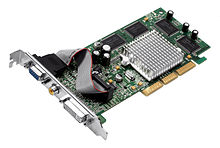Advantages over PCI
As computers became increasingly graphically oriented, successive generations of graphics adapters began to push the limits of PCI, a bus with shared bandwidth. This led to the development of AGP, a "bus" dedicated to graphics adapters.
The primary advantage of AGP over PCI is that it provides a dedicated pathway between the slot and the processor rather than sharing the PCI bus. In addition to a lack of contention for the bus, the point-to-point connection allows for higher clock speeds. AGP also uses sideband addressing, meaning that the address and data buses are separated so the entire packet does not need to be read to get addressing information. This is done by adding eight extra 8-bit buses which allow the graphics controller to issue new AGP requests and commands at the same time with other AGP data flowing via the main 32 address/data (AD) lines. This results in improved overall AGP data throughput.
In addition, to load a texture, a PCI graphics card must copy it from the system's RAM into the card's framebuffer, whereas an AGP card is capable of reading textures directly from system RAM using the Graphics Address Remapping Table (GART). GART reapportions main memory as needed for texture storage, allowing the graphics card to access them directly. The maximum amount of system memory available to AGP is defined as the AGP aperture.
The two main reasons graphics cards with the PCI interface are still produced are that, first, they can be used in nearly any PC; because while some motherboards with built-in graphics adapters lack an AGP slot, few, if any, modern desktop PCs lack PCI slots. Secondly, a user with an appropriate operating system can use several PCI graphics cards (or several PCI graphics cards in combination with one AGP card) simultaneously — to give many different video outputs (for the use of many screens). This is almost impossible with AGP 1.0 and AGP 2.0 cards, because they do not support more than one AGP Master (video card) per AGP Target (chipset interface). AGP 3.0 does support more than one AGP Master per AGP Target, but nonetheless few PC motherboards are equipped with more than one AGP slot. Some server-class computers support having multiple AGP slots in a single system: the HP AlphaServer GS1280 has up to 6 AGP slots, the AlphaServer ES80 up to 4 AGP slots, and the AlphaServer ES47 up to 2 AGP slots.
History
The AGP slot first appeared on x86 compatible system boards based on Socket 7 Intel P5 Pentium and Slot 1 P6 Pentium II processors. Intel introduced AGP support with the i440LX Slot 1 chipset on the 26th of August 1997 and a flood of products followed from all the major system board vendors.
The first Socket 7 chipsets to support AGP were the VIA Apollo VP3, SiS 5591/5592, and the ALI Aladdin V. Intel never released an AGP-equipped Socket 7 chipset. FIC demonstrated the first Socket 7 AGP system board in November 1997 as the FIC PA-2012 based on the VIA Apollo VP3 chipset, followed very quickly by the EPoX P55-VP3 also based on the VIA VP3 chipset which was first to market.
Early video chipsets featuring AGP support included the Rendition Vérité V2200, 3dfx Voodoo Banshee, Nvidia RIVA 128, 3Dlabs PERMEDIA 2, Intel i740, ATI Rage series, Matrox Millennium II, and S3 ViRGE GX/2. Some early AGP boards used graphics processors built around PCI and were simply bridged to AGP. This resulted in the cards benefiting little from the new bus, with the only improvement used being the 66 MHz bus clock, with its resulting doubled bandwidth over PCI, and bus exclusivity. Examples of such cards were the Voodoo Banshee, Vérité V2200, Millennium II, and S3 ViRGE GX/2. Intel's i740 was explicitly designed to exploit the new AGP feature set. In fact it was designed to texture only from AGP memory, making PCI versions of the board difficult to implement (local board RAM had to emulate AGP memory.)
Microsoft first introduced AGP support into Windows 95 OEM Service Release 2 (OSR2 version 1111 or 950B) via the USB SUPPLEMENT to OSR2 patch. After applying the patch the Windows 95 system became Windows 95 version 4.00.950 B. The first Windows NT-based operating system to receive AGP support was Windows NT 4.0 with service pack 3, introduced in 1997. Linux support for AGP enhanced fast data transfers was first added in 1999 with the implementation of the AGPgart kernel module.
Compatibility
Compatibility, AGP Keys on card (top), on slot (bottom)
AGP cards are backward and forward compatible within limits. 1.5 V-only keyed cards will not go into 3.3 V slots and vice versa, though "Universal" slots exist which accept either type of card. AGP Pro cards will not fit into standard slots, but standard AGP cards will work in a Pro slot. Some cards, like Nvidia's GeForce 6 series (except the 6200) or ATI's Radeon X800 series, only have keys for 1.5 V to prevent them from being installed in older mainboards without 1.5 V support. Some of the last modern cards with 3.3 V support were the Nvidia GeForce FX series (FX 5200, FX 5500, FX 5700, some FX 5800, FX 5900 and some FX 5950) and the ATI Radeon 9500/9700/9800(R350) (but not 9600/9800(R360)). Some Geforce 6200 cards will function with AGP 1.0 (3.3v) slots.
It is important to check voltage compatibility as some cards incorrectly have dual notches and some motherboards incorrectly have fully open slots. Furthermore, some poorly designed older 3.3 V cards incorrectly have the 1.5 V key. Inserting a card into a slot that does not support the correct signaling voltage may cause damage.
Motherboard slots with both 3.3 V and 1.5 V keys do not exist.
There are some proprietary exceptions to this rule. For example, Apple Power Macintosh computers with the Apple Display Connector (ADC) have an extra connector which delivers power to the attached display. Additionally, moving cards between computers of various CPU architectures may not work due to firmware issues.
Use today
As of 2010, few new motherboards feature AGP slots. No new motherboard chipsets are equipped with AGP support, but motherboards continue to be produced with older chipsets that have AGP support. PCI Express allows for higher data transfer rates, has more robust full-duplex support, and also supports other devices.
All new graphics processors are designed for PCI-Express. To create AGP graphics cards, those chips require an additional PCIe to AGP bridge chip to convert PCIe signals to and from AGP signals. This incurs additional board costs due to the need for the additional bridge chip and for a separate AGP-designed circuit board.
Various manufacturers of graphics cards continue to produce AGP cards for the shrinking AGP user-base. The first bridged cards were the GeForce 6600 and ATI Radeon X800 XL boards, released during 2004-5. As of 2009, AGP cards from Nvidia have a ceiling of the GeForce 7 Series. As of 2009, DirectX 10-capable AGP cards from ATI include the Radeon HD 2400, 2600, 3650, and 3850 and the Radeon HD 4650, 4670.





